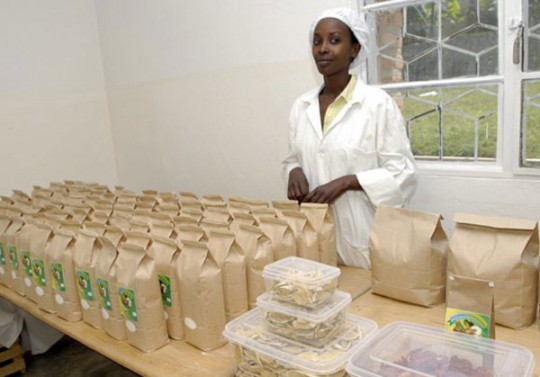Developing countries spur growth in global manufacturing output – UN
Developing countries spur growth in global manufacturing output – UN
1 December 2011 –
The growth in manufacturing output in major economies indicates that a further worldwide downturn in industrial production is not imminent, UNIDO said in its quarterly report on world manufacturing production.
Global manufacturing output rose by 5.5 per cent overall, compared to the same period last year, spurred mainly by growth in developing countries where manufacturing output increased by 13 per cent.
China’s manufacturing, which accounts for almost half of all developing countries combined, grew by 14.5 per cent in the third quarter, while the output of industrialized countries rose by an average of 3.3 per cent.
United States manufacturing grew by 4.1 per cent, while Japan’s industrial performance improved significantly with output rising by 4.3 per cent, compared to the second quarter of this year. Japan’s output is, however, still below last year’s levels.
The impact of the Eurozone’s financial instability has so far been limited to a few countries, UNIDO noted in its report.
In Europe, strong growth in manufacturing output was observed in Austria (7.2 per cent), the Czech Republic (5.5 per cent), Germany (9.6 per cent) and Sweden (6.4 per cent).
Relatively higher growth performance was observed in Eastern Europe. The manufacturing output of Poland and Romania grew by 6.5 per cent and 6.1 per cent, respectively. Russia’s manufacturing grew by 7.2 per cent.
Moderate growth was observed in France and the United Kingdom, but Italy’s production dropped. Similarly, manufacturing output fell in Greece, Portugal and Spain.
Among developing countries, strong growth was seen in Malaysia (5.2 per cent), Turkey (7.8 per cent), and Viet Nam (7.4 per cent).
Growth in leading developing economies was, however, moderate. Argentina’s output increased by 3.8 per cent, Brazil by 0.1 per cent, India by 3.1 per cent, and Mexico by 4.6 per cent.
The report also presents the growth figures of manufacturing sectors. Industrialized countries have performed relatively well in high-technology sectors, such as machinery and equipment, and the production of motor vehicles and office and computing machinery, while developing countries dominated the growth figures for the processing of primary products, such as food and beverages, textiles, garment apparel, and fabricated metal products.
###
01 December 2011
World industrial output grows in the third quarter, despite Euro zone financial instability, according to UNIDO report
VIENNA, 1 December 2011 – Amid fears of another recession due to instability in European financial markets, world manufacturing production has increased slightly in the third quarter, compared to the second quarter of 2011. Consistent growth of manufacturing output in major economies indicates that a further worldwide downturn in industrial production is not imminent, according to a report released today by the United Nations Industrial Development Organization (UNIDO).
The report states that world manufacturing output rose by 5.5 per cent in the third quarter of 2011, compared to the same period of 2010. This growth is mainly attributed to developing countries, whose manufacturing output increased by 13 per cent. China’s manufacturing, which accounts for almost half of that of all developing countries combined, grew by 14.5 per cent in the third quarter.
The manufacturing output of industrialized countries rose by an average of 3.3 per cent in the third quarter. U.S. manufacturing grew by 4.1 per cent. Japan’s manufacturing performance improved significantly in recent months. Its output grew by 4.3 per cent in the third quarter, compared to second quarter of 2011, but it has not yet reached the level of last year.
The impact of Euro zone financial instability is so far limited to just a few countries. In Europe, strong growth of manufacturing output was observed in Austria (7.2 per cent), the Czech Republic (5.5 per cent), Germany (9.6 per cent) and in Sweden (6.4 per cent). Relatively higher growth performance was observed in Eastern Europe. The manufacturing output of Poland and Romania grew by 6.5 per cent and 6.1 per cent, respectively. The manufacturing output of the Russian Federation grew by 7.2 per cent.
Moderate growth was observed in France and the United Kingdom, however Italy’s manufacturing output dropped in the third quarter, compared to the previous quarter. Similarly, manufacturing output fell in Greece, Portugal and Spain.
Among developing countries, strong growth was seen in Malaysia (5.2 per cent), Turkey (7.8 per cent), and Viet Nam (7.4 per cent). However, the growth of leading developing economies was moderate. The manufacturing output of Argentina increased by 3.8 per cent, Brazil by 0.1 per cent, India by 3.1 per cent, and Mexico by 4.6 per cent.
The report also presents the growth figures of manufacturing sectors. Industrialized countries have performed relatively well in high-technology sectors, such as machinery and equipment, and the production of motor vehicles and office and computing machinery, while developing countries dominated the growth figures for the processing of primary products, such as food and beverages, textiles, garment apparel, and fabricated metal products.
UNIDO Statistics publishes quarterly production estimates in order to inform international data users about the current status and growth trends of world manufacturing output. Annual data on production, employment and capital formation is published in the International Yearbook of Industrial Statistics.
UNIDO maintains an international industrial statistical database in accordance with the mandate of the United Nations Statistics Commission. Data is disseminated through report publications, CD products and online access.
In addition to data products, UNIDO also publishes methodological papers and reports on statistics. A new publication, Industrial Statistics: Guidelines and Methodology, is now available for free download from the UNIDO website.
Please go here
For further information on the Q3 Report, please contact:
Shyam Upadhyaya
UNIDO Chief Statistician
###
Report on the World Manufacturing Production
UNIDO Statistics publishes a new series of reports about current growth trends of the world manufacturing production, which is based on production data collected and published by the National Statistical Offices (NSOs). A preliminary report was prepared earlier to check the availability of data and efficiency of statistical method employed for this purpose. After an assessment period of data production for internal use, the results are now ready for worldwide dissemination.
The main objective of this report is to provide an overview of the current growth trends of the world manufacturing production by country groups and by major sectors. For years UNIDO statistical publications have been released only on the annual basis. While researchers devoted in fundamental economic studies prefer detail business structure statistics, other international data users, especially, policymakers and business associations require more recent assessment of the overall production growth trends. In order to meet the user’s demand in current industrial statistics as well as to present the growth assessment of the Organization in its capacity of a specialized UN agency in the field of the industrial developments, UNIDO presents this report with latest growth estimates for overall manufacturing industry as well as for its major branches.




###
> United Nations (UN).
 The United Nations was established on 24 October 1945 by 51 countries committed to preserving peace through international cooperation and collective security. Today, nearly every nation in the world belongs to the UN: membership totals 192 countries.
The United Nations was established on 24 October 1945 by 51 countries committed to preserving peace through international cooperation and collective security. Today, nearly every nation in the world belongs to the UN: membership totals 192 countries.
When States become Members of the United Nations, they agree to accept the obligations of the UN Charter, an international treaty that sets out basic principles of international relations. According to the Charter, the UN has four purposes:
- to maintain international peace and security;
- to develop friendly relations among nations;
- to cooperate in solving international problems and in promoting respect for human rights;
- and to be a centre for harmonizing the actions of nations.
###
* The above story is adapted from materials provided by United Nations (UN)
** More information at United Nations (UN)





















